
941 – Double Cubic Altar
- Physical description:
- Double cube altar - on the top, a human figure within concentric coloured circles; top cube - watchtowers of the Golden Dawn as revealed by John Dee, bottom cube - Enochian tablets.
- Museum classification:
- Ritual Magic
- Size:
- 480 x 240 x 240 mm
- Information:
Document 9115 (a handwritten note by Cecil Williamson) describes this object:
Small ritual altar showing the use of secret Enochian symbols. This altar is made to the design and employs the secret alphabet of Dr. John Dee the famous astrologer and magician who lived in the reign of the first Queen Elisabeth.
Cecil's description is a little misleading (as far as the present writer is aware, Dee did not design an altar, he used the Holy Table) as this double cubic altar was created according to designs published by Aleister Crowley in Book 4, Part 2 (see book in Museum library owned by Cecil Williamson). This altar is based on a design drawn by Aleister Crowley (see below) and developed by Steffi Grant. The whole altar was drawn by Steffi Grant and published in Hidden Lore: Hermetic Glyphs (a book in the Museum library). It resembles in some ways a Masonic double cube or a Golden Dawn altar.

It is a double cube and should be the height of the navel of the magician (see picture below, it comes to the height of Cecil’s stomach). Unfortunately, the original, full size altar is no longer in the Museum collection but we still have the smaller version on display here.

Crowley wrote in Book 4, Part 2 (there is a copy in the Museum library):
“The altar represents the solid basis of the work, the fixed Will of the Magician; and the law under which he works…The top is Kether, and the bottom Malkuth…this altar must embody the Magician’s knowledge of the laws of Nature, which are the laws through which he works...”
The sides of the altar include Enochian tablets at the bottom with symbols of the Watchtowers above them. These were discovered by John Dee and Edward Kelley in the 1580s (see object 1160) and developed by the Golden Dawn in the 1880s (see Hidden Lore: Hermetic Glyphs in the Museum library for more details on this).
The top of the altar is a version of Robert Fludd’s Macrocosm and Microcosm (Crowley calls it Man of Vitruvius in Book 4, Part 2), it is also called Adam Kadmon in document 692 in the Museum archive (written by Gerald Yorke). His body forms a pentacle or five pointed star. In ritual magic, the pentacle symbolises the microcosm (that which is below i.e. on Earth: the four elements of matter and also the fifth element, the quintessence, the spirit). The rings around the man represent the spheres of the universe: the planets, the heavenly realms (that which is above).
The original Robert Fludd image is shown below top and the top of the altar is shown below in colour.
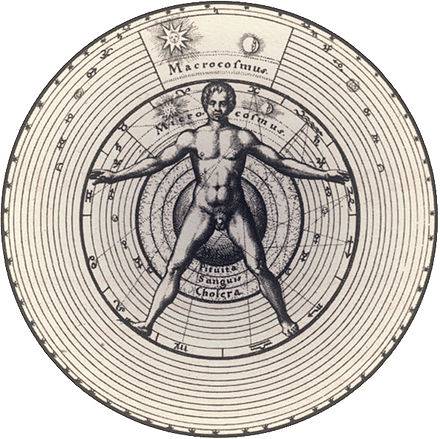
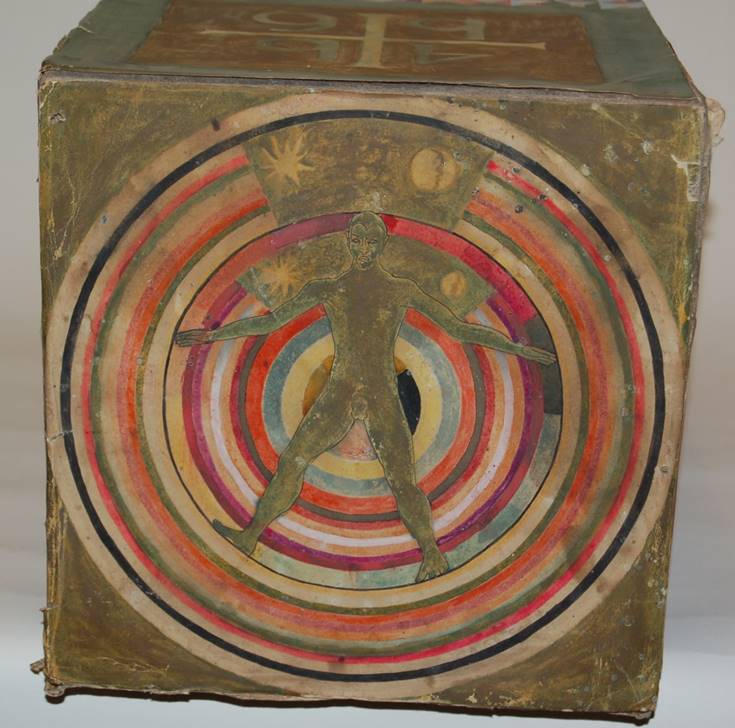
Below: the side for Fire.
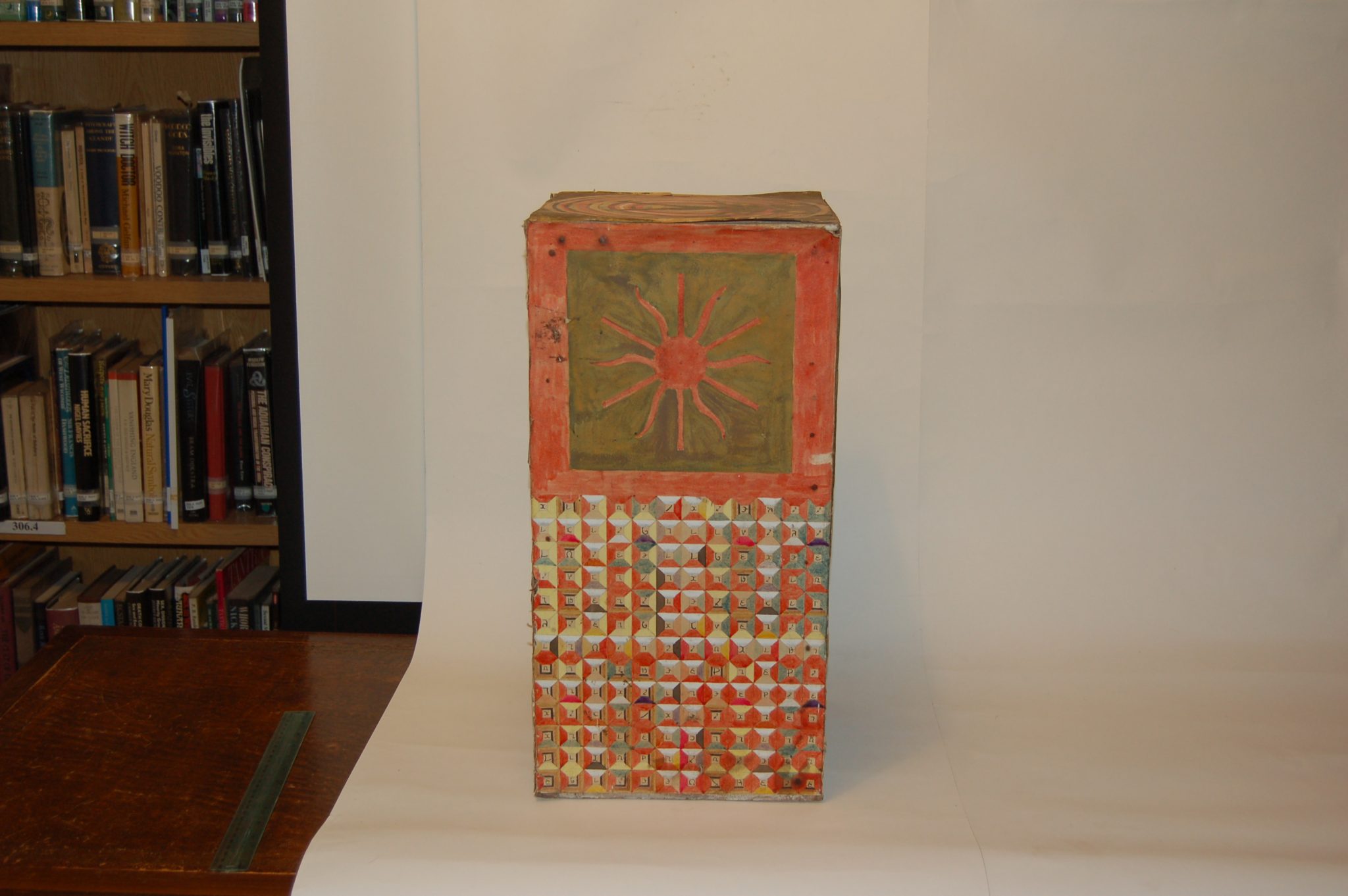
Below: the side for Earth.
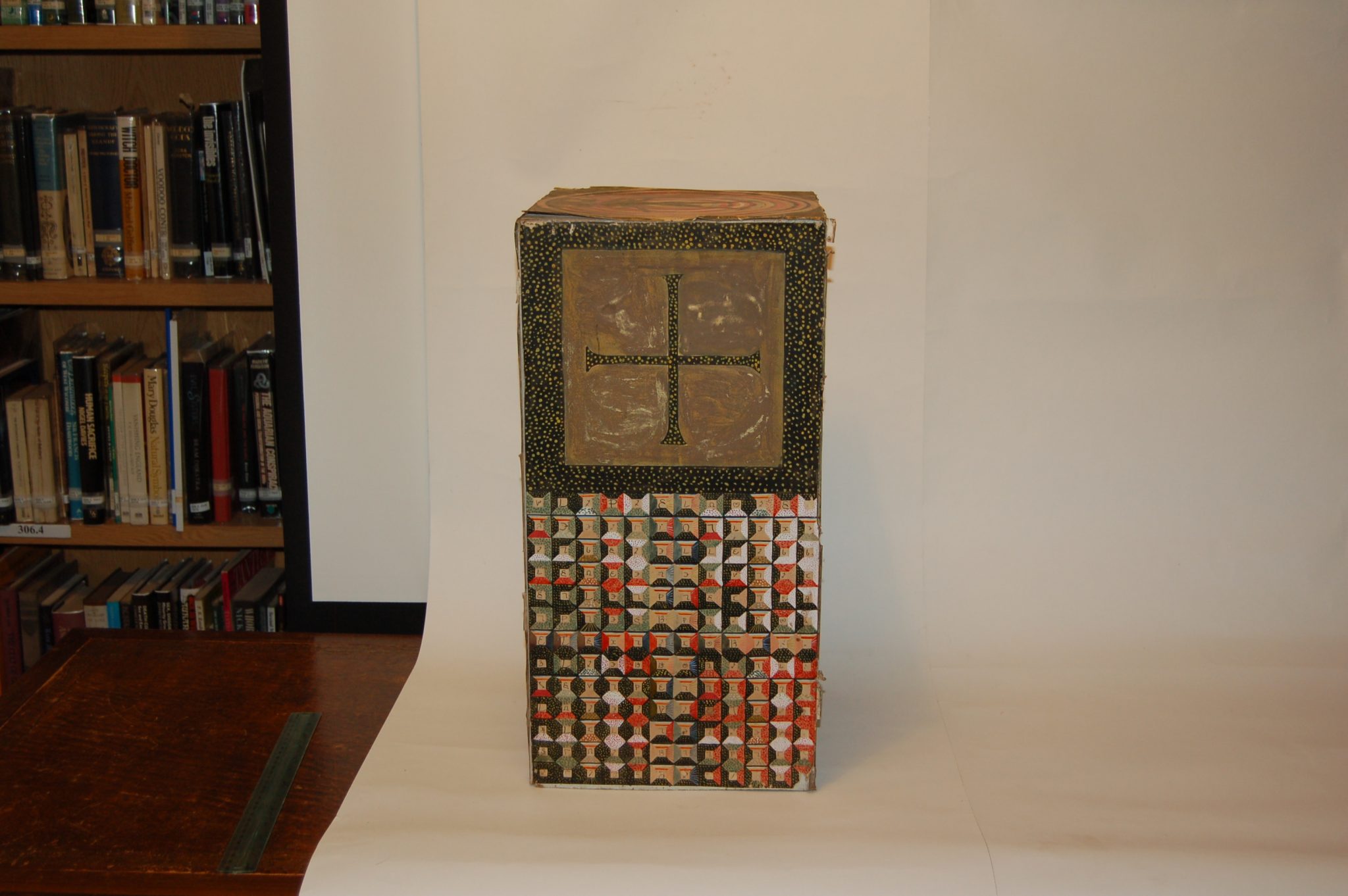
Below: the side for Air.
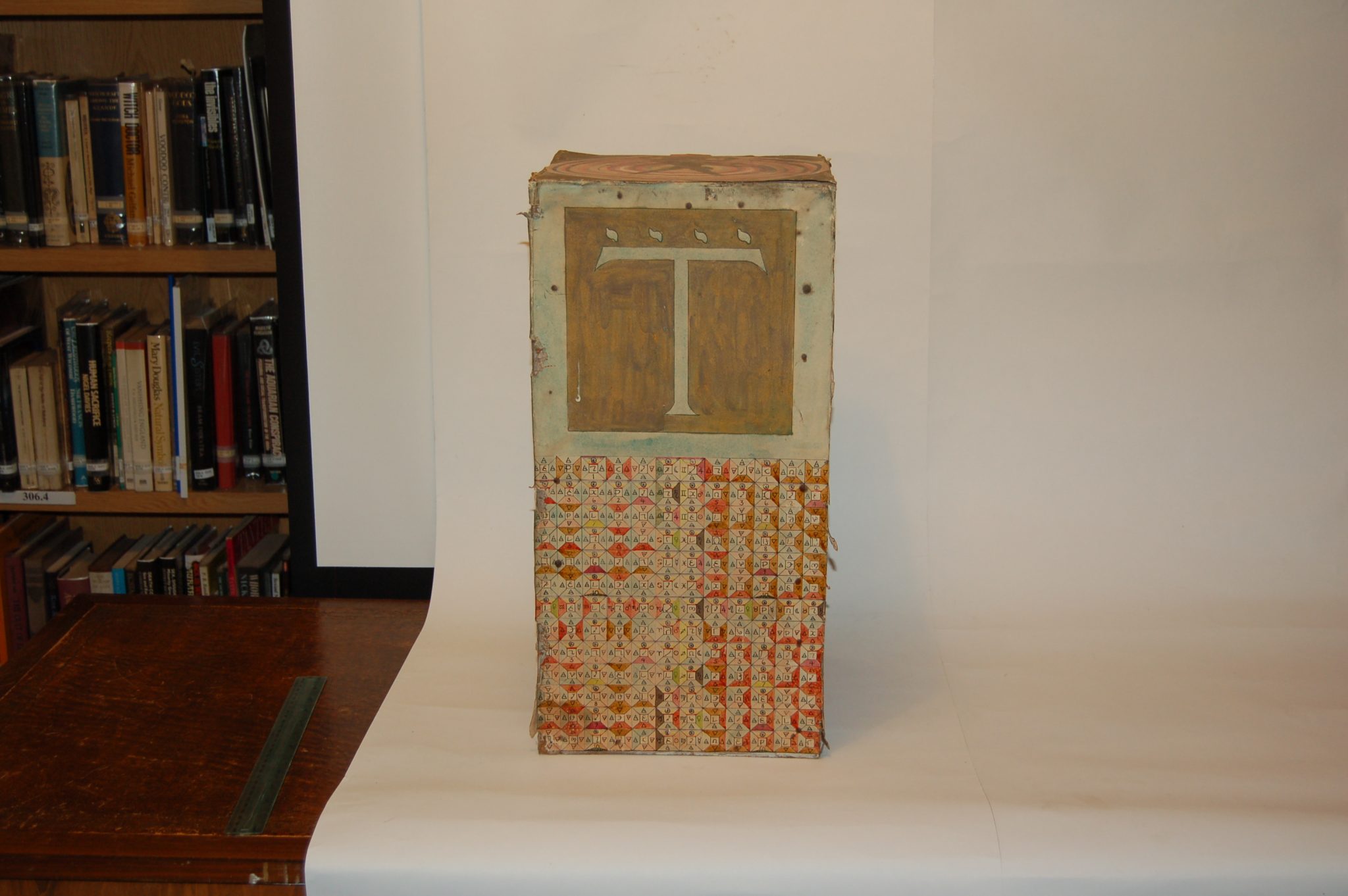
Below: Side for Water.
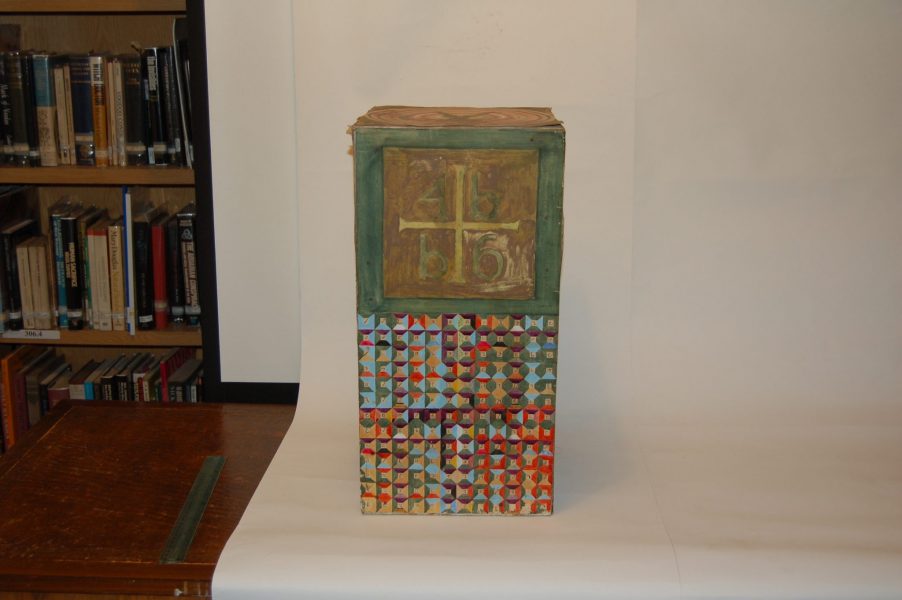
The Circle (sketch drawn by Steffi Grant, see object number 3944).
The altar is at the centre of the circle. It stands within a Tau Cross of ten squares (representing the Ten Sephiroth of the Qabalah). The altar stands on the square of Malkuth: Crowley says, “The top is Kether and the bottom Malkuth”.
The circle is green with names of God written in Hebrew letters in red (we think Cecil had these made out of iron and placed on the circle for extra protection). Outside the circle are nine pentagrams in the centre of each one should burn a candle. Steffi Grant advised Cecil that, “Dirty grey is ideal for the outside of the Circle as it represents the untamed wastes of chaos.”
We know Cecil used this circle and the triangle outside of it, let us hope that he followed Crowley’s advice, “Once the circle is made and consecrated, the Magician must not leave it, or even lean outside it, lest he be destroyed by the hostile forces without.”
The original, full size altar can be seen below in the Isle of Man's ritual magic display.
The floor is painted according to the circle plan drawn by Steffi Grant (object 3944).
The altar stands on the correct square of the Tau Cross and has a bell and candle on top of it (as Crowley specified it should).
In the background is the Greek Solar Cross (object number 3947).
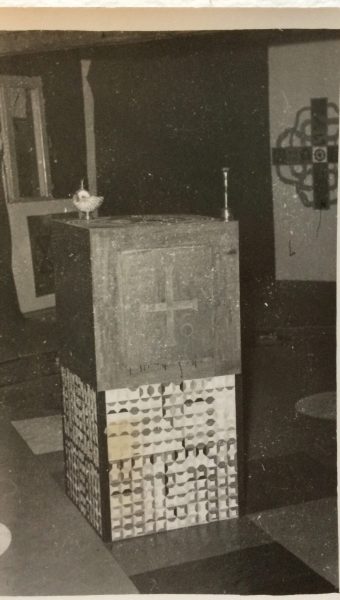
Photo below: shows another view of the altar within the Circle, on the correct square of the Tau Cross. The candlesticks can also be seen and the Greek Solar Zodiac. The large incense burner is also the style that Crowley proscribed in Book 4, Part 2.
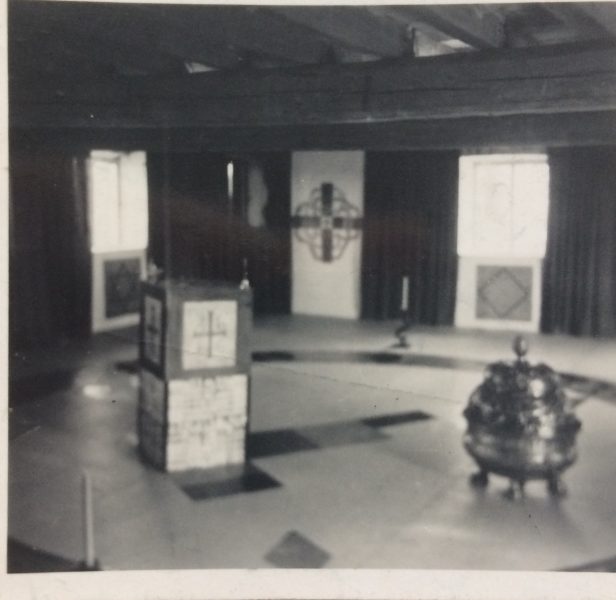
Cecil was photographed using this room for an article in the 1950s (see below - photographs from Museum archive).
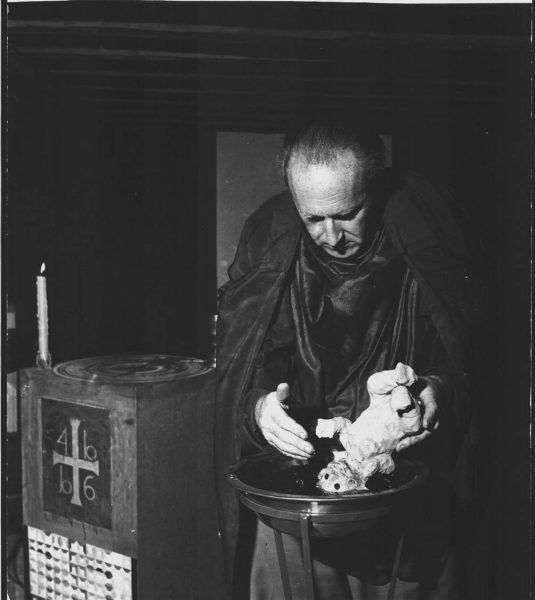

Photo below shows Cecil completing a counter-curse using the Triangle of Art outside the Circle. Interestingly, this triangle does not appear on Steffi's sketch and Gerald Yorke advised against creating it in a letter to Cecil about this display (Cecil seems to have ignored him and created one anyway).

Gerald Gardner was photographed in a similar room in the Witch's Mill (the Magicians Room) with a more standard style double cubic altar (note the gargoyle in his Triangle of Art or invocation/evocation).
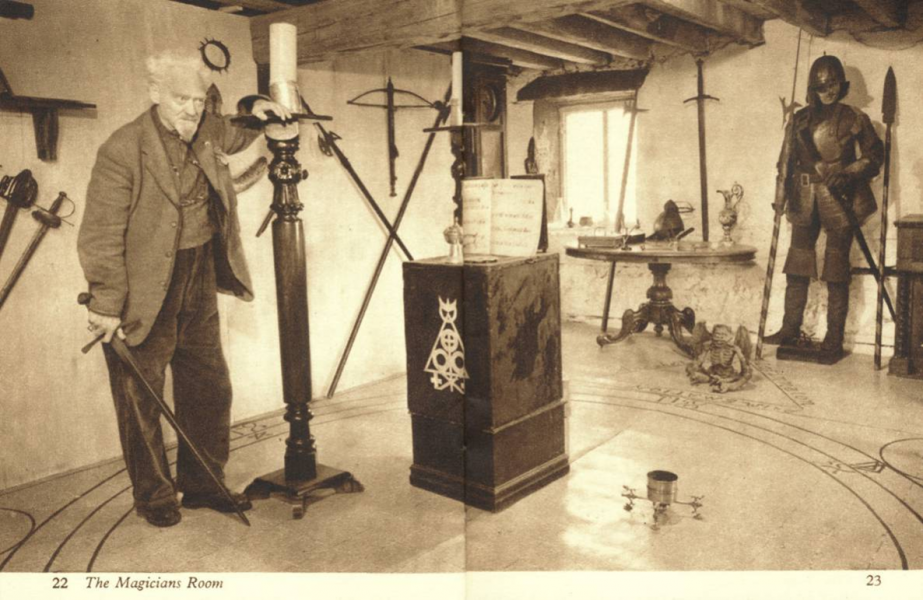
Gerald Yorke wrote a guidebook for this room. It is in the Museum archive (document number 692). He describes it as a GD (Golden Dawn)/AA (Argentum Astratum) room. It is a temple as laid out by Crowley in Book 4, Part 2 and created by his acolytes (Steffi Grant, Gerald Yorke, Cecil Williamson) and visited by his friends (Frieda Harris is mentioned in a letter in the Museum archive. She was going to visit with Gerald Yorke).
This object has been on display in the Museum for many years, in 2018 it was the main focus of the exhibition "Dew of Heaven: Objects of Ritual Magic" and featured on the front cover of the exhibition guidebook (photographed on a black background by Malcolm Baker).
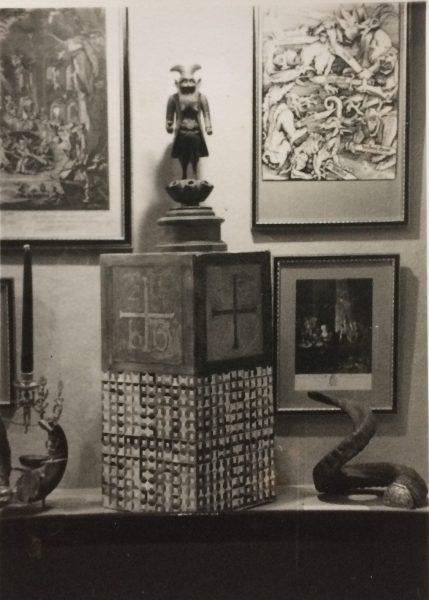
Photo above shows the altar on display in the Boscastle Museum in Cecil's day.
Photos below show the altar in the Ritual Magic display created by Graham King after the 2004 flood.
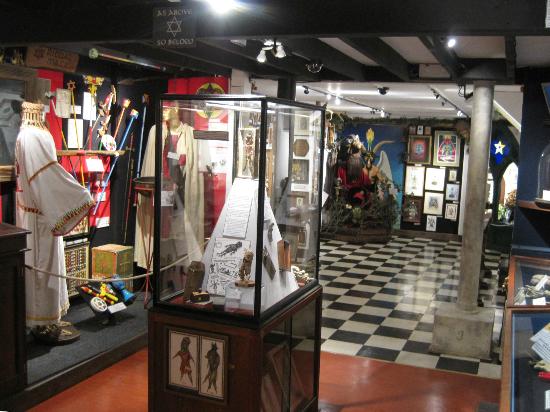
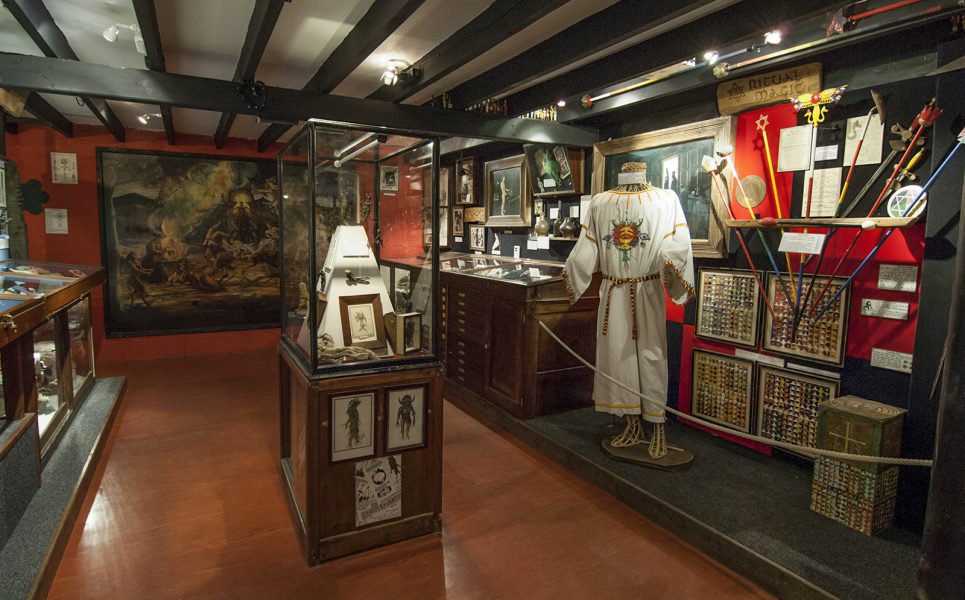
Photo below shows altar in 2018 exhibition.
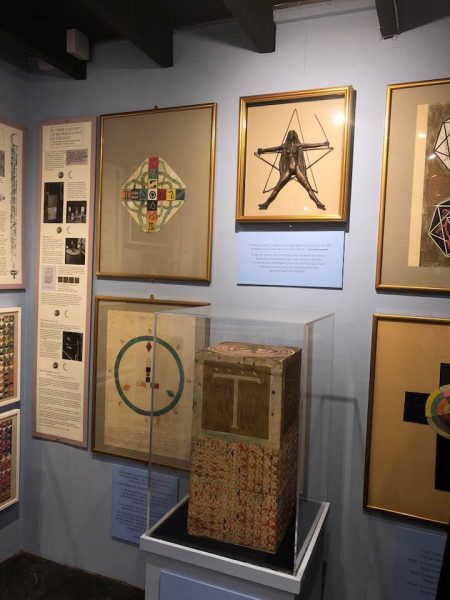
In 2018, it had some much needed conservation after years on display. The conservation report can be read here:
MoW&M Conservation Treatment Report altar.doc
A brief history of the Steffi Grant Collection
A set of original sketches and diagrams for a Museum display, reproductions of those diagrams in a larger scale and a double cubic altar.
Similar to the images Steffi Grant created for the Carfax Monographs (1959-1962) but created in 1951. See Kenneth and Steffi Grant’s Hidden Lore: Hermetic Glyphs (Fulgur Press) in the Museum library for more details.
Object numbers: 3941-3950 (inclusive),1163 and possibly 3956. Also double cubic altar (941) and angelic scrying tablets (1160).
Cecil Williamson’s notes and old interpretation cards from the Museum suggest that he had a profound respect for, and deep interest in, Aleister Crowley. See documents 8282 and 8277 and the interview with Cecil in Talking Stick magazine about Crowley (in the Museum library) for more on his attitude to him.
One letter sent to Gerald Yorke in 1952 (transcribed by Dave Evans from an original in the Warburg Institute) even suggests that the Museum may have been somehow inspired by Crowley. See documents 887 and 888.
The Museum used to have a lot of objects which were either inspired by Crowley or owned by him (according to Cecil) including a seven headed demon stick, Baphomet ring and paintings. There is also reference to a handwritten copy of the Book of the Law and a copy of Crowley’s funeral service (one wonders how this was obtained by Cecil – by purchase, gift from someone who was there or is it possible that Cecil attended the funeral?) See documents 9013, 10129 or search Crowley in documents to see the complete list).
One document (8267) mentions a range of magical drawings, made by a student while under the instruction of Aleister Crowley. In it, Cecil says that no excuse is made for their condition. It is highly likely that this card refers to the drawings created by Steffi Grant in 1951 for the Museum when it was at the Witches’s Mill on the Isle of Man (objects 3941-3950).
There are several documents in the Museum archive that relate to this display (for a look at the display itself see object 941, double cubic altar).
There are around 20 letters from Gerald Yorke. From these, we can infer that Cecil approached him asking for help establishing a temple room in the Mill. Gerald seems to have contacted Kenneth and Steffi Grant and liased with them about the display and it developed into a Temple which is mainly based on Crowley’s Book 4, Part 2. Gerald Yorke wrote a guidebook for it which includes substantial quotes from Book 4, Part 2. See document 692 for the complete text. Gerald Yorke also mentions John Symonds (Crowley’s literary executor and first biographer) in one letter and visiting the Mill with Lady Frieda Harris (who created the Thoth Tarot with Crowley) in another letter.
The designs were completed by Steffi and sent to Cecil with instructions. There are numerous letters from Kenneth and Steffi Grant which deal with this display (see 93, 96, 97, X98, 99, 100, 101).
Cecil does not seem to have paid Steffi for this work and Kenneth suggests in a letter that Cecil could pay for the British OTO manifesto to be printed in recompense for Steffi’s work on the display. Several letters mention this manifesto and the dye that was to be used in making it.
Cecil obviously held on to many of these objects and drawings when he moved the Museum from the Isle of Man. He must also have written to Kenneth Anger (probably in 1955) as document number 271 is a letter from Anger while at Cefalu. It seems that Cecil was trying to acquire Crowley objects from the Abbey and that he and Kenneth Anger were going to create some sort of reconstruction of it at the Museum while it was in Windsor.
It is possible that one more object was created by Steffi Grant, this is object number 3956 (Witch’s Cradle painting). A photograph of this object was shown to Steffi in 2018 by Professor Henrik Bogdan and she does not remember creating it. However it is similar to the style of her work (see front cover of Kenneth Grant’s book ‘Snakewand’).
Cecil seemed to admire the Grants long after their collaboration had ended. He purchased and heavily annotated a first edition of Kenneth Grant’s “Magical Revival” (now in the Museum library). A letter in the Museum archive (document 180) was written by Cecil in 1982 and talks warmly of the Grants as being knowledgeable occultists and lovely people.
- Resource:
- Object
- Materials:
- Paper, wood
- Copyright ownership:
- MWM
Document 9115 (a handwritten note by Cecil Williamson) describes this object:
Small ritual altar showing the use of secret Enochian symbols. This altar is made to the design and employs the secret alphabet of Dr. John Dee the famous astrologer and magician who lived in the reign of the first Queen Elisabeth.
Cecil's description is a little misleading (as far as the present writer is aware, Dee did not design an altar, he used the Holy Table) as this double cubic altar was created according to designs published by Aleister Crowley in Book 4, Part 2 (see book in Museum library owned by Cecil Williamson). This altar is based on a design drawn by Aleister Crowley (see below) and developed by Steffi Grant. The whole altar was drawn by Steffi Grant and published in Hidden Lore: Hermetic Glyphs (a book in the Museum library). It resembles in some ways a Masonic double cube or a Golden Dawn altar.

It is a double cube and should be the height of the navel of the magician (see picture below, it comes to the height of Cecil’s stomach). Unfortunately, the original, full size altar is no longer in the Museum collection but we still have the smaller version on display here.

Crowley wrote in Book 4, Part 2 (there is a copy in the Museum library):
“The altar represents the solid basis of the work, the fixed Will of the Magician; and the law under which he works…The top is Kether, and the bottom Malkuth…this altar must embody the Magician’s knowledge of the laws of Nature, which are the laws through which he works...”
The sides of the altar include Enochian tablets at the bottom with symbols of the Watchtowers above them. These were discovered by John Dee and Edward Kelley in the 1580s (see object 1160) and developed by the Golden Dawn in the 1880s (see Hidden Lore: Hermetic Glyphs in the Museum library for more details on this).
The top of the altar is a version of Robert Fludd’s Macrocosm and Microcosm (Crowley calls it Man of Vitruvius in Book 4, Part 2), it is also called Adam Kadmon in document 692 in the Museum archive (written by Gerald Yorke). His body forms a pentacle or five pointed star. In ritual magic, the pentacle symbolises the microcosm (that which is below i.e. on Earth: the four elements of matter and also the fifth element, the quintessence, the spirit). The rings around the man represent the spheres of the universe: the planets, the heavenly realms (that which is above).
The original Robert Fludd image is shown below top and the top of the altar is shown below in colour.


Below: the side for Fire.

Below: the side for Earth.

Below: the side for Air.
Below: Side for Water.

The Circle (sketch drawn by Steffi Grant, see object number 3944).
The altar is at the centre of the circle. It stands within a Tau Cross of ten squares (representing the Ten Sephiroth of the Qabalah). The altar stands on the square of Malkuth: Crowley says, “The top is Kether and the bottom Malkuth”.
The circle is green with names of God written in Hebrew letters in red (we think Cecil had these made out of iron and placed on the circle for extra protection). Outside the circle are nine pentagrams in the centre of each one should burn a candle. Steffi Grant advised Cecil that, “Dirty grey is ideal for the outside of the Circle as it represents the untamed wastes of chaos.”
We know Cecil used this circle and the triangle outside of it, let us hope that he followed Crowley’s advice, “Once the circle is made and consecrated, the Magician must not leave it, or even lean outside it, lest he be destroyed by the hostile forces without.”
The original, full size altar can be seen below in the Isle of Man's ritual magic display.
The floor is painted according to the circle plan drawn by Steffi Grant (object 3944).
The altar stands on the correct square of the Tau Cross and has a bell and candle on top of it (as Crowley specified it should).
In the background is the Greek Solar Cross (object number 3947).

Photo below: shows another view of the altar within the Circle, on the correct square of the Tau Cross. The candlesticks can also be seen and the Greek Solar Zodiac. The large incense burner is also the style that Crowley proscribed in Book 4, Part 2.

Cecil was photographed using this room for an article in the 1950s (see below - photographs from Museum archive). 

Photo below shows Cecil completing a counter-curse using the Triangle of Art outside the Circle. Interestingly, this triangle does not appear on Steffi's sketch and Gerald Yorke advised against creating it in a letter to Cecil about this display (Cecil seems to have ignored him and created one anyway).

Gerald Gardner was photographed in a similar room in the Witch's Mill (the Magicians Room) with a more standard style double cubic altar (note the gargoyle in his Triangle of Art or invocation/evocation).

Gerald Yorke wrote a guidebook for this room. It is in the Museum archive (document number 692). He describes it as a GD (Golden Dawn)/AA (Argentum Astratum) room. It is a temple as laid out by Crowley in Book 4, Part 2 and created by his acolytes (Steffi Grant, Gerald Yorke, Cecil Williamson) and visited by his friends (Frieda Harris is mentioned in a letter in the Museum archive. She was going to visit with Gerald Yorke).
This object has been on display in the Museum for many years, in 2018 it was the main focus of the exhibition "Dew of Heaven: Objects of Ritual Magic" and featured on the front cover of the exhibition guidebook (photographed on a black background by Malcolm Baker).

Photo above shows the altar on display in the Boscastle Museum in Cecil's day.
Photos below show the altar in the Ritual Magic display created by Graham King after the 2004 flood.


Photo below shows altar in 2018 exhibition.

In 2018, it had some much needed conservation after years on display. The conservation report can be read here:
MoW&M Conservation Treatment Report altar.doc
A brief history of the Steffi Grant Collection
A set of original sketches and diagrams for a Museum display, reproductions of those diagrams in a larger scale and a double cubic altar.
Similar to the images Steffi Grant created for the Carfax Monographs (1959-1962) but created in 1951. See Kenneth and Steffi Grant’s Hidden Lore: Hermetic Glyphs (Fulgur Press) in the Museum library for more details.
Object numbers: 3941-3950 (inclusive),1163 and possibly 3956. Also double cubic altar (941) and angelic scrying tablets (1160).
Cecil Williamson’s notes and old interpretation cards from the Museum suggest that he had a profound respect for, and deep interest in, Aleister Crowley. See documents 8282 and 8277 and the interview with Cecil in Talking Stick magazine about Crowley (in the Museum library) for more on his attitude to him.
One letter sent to Gerald Yorke in 1952 (transcribed by Dave Evans from an original in the Warburg Institute) even suggests that the Museum may have been somehow inspired by Crowley. See documents 887 and 888.
The Museum used to have a lot of objects which were either inspired by Crowley or owned by him (according to Cecil) including a seven headed demon stick, Baphomet ring and paintings. There is also reference to a handwritten copy of the Book of the Law and a copy of Crowley’s funeral service (one wonders how this was obtained by Cecil – by purchase, gift from someone who was there or is it possible that Cecil attended the funeral?) See documents 9013, 10129 or search Crowley in documents to see the complete list).
One document (8267) mentions a range of magical drawings, made by a student while under the instruction of Aleister Crowley. In it, Cecil says that no excuse is made for their condition. It is highly likely that this card refers to the drawings created by Steffi Grant in 1951 for the Museum when it was at the Witches’s Mill on the Isle of Man (objects 3941-3950).
There are several documents in the Museum archive that relate to this display (for a look at the display itself see object 941, double cubic altar).
There are around 20 letters from Gerald Yorke. From these, we can infer that Cecil approached him asking for help establishing a temple room in the Mill. Gerald seems to have contacted Kenneth and Steffi Grant and liased with them about the display and it developed into a Temple which is mainly based on Crowley’s Book 4, Part 2. Gerald Yorke wrote a guidebook for it which includes substantial quotes from Book 4, Part 2. See document 692 for the complete text. Gerald Yorke also mentions John Symonds (Crowley’s literary executor and first biographer) in one letter and visiting the Mill with Lady Frieda Harris (who created the Thoth Tarot with Crowley) in another letter.
The designs were completed by Steffi and sent to Cecil with instructions. There are numerous letters from Kenneth and Steffi Grant which deal with this display (see 93, 96, 97, X98, 99, 100, 101).
Cecil does not seem to have paid Steffi for this work and Kenneth suggests in a letter that Cecil could pay for the British OTO manifesto to be printed in recompense for Steffi’s work on the display. Several letters mention this manifesto and the dye that was to be used in making it.
Cecil obviously held on to many of these objects and drawings when he moved the Museum from the Isle of Man. He must also have written to Kenneth Anger (probably in 1955) as document number 271 is a letter from Anger while at Cefalu. It seems that Cecil was trying to acquire Crowley objects from the Abbey and that he and Kenneth Anger were going to create some sort of reconstruction of it at the Museum while it was in Windsor.
It is possible that one more object was created by Steffi Grant, this is object number 3956 (Witch’s Cradle painting). A photograph of this object was shown to Steffi in 2018 by Professor Henrik Bogdan and she does not remember creating it. However it is similar to the style of her work (see front cover of Kenneth Grant’s book ‘Snakewand’).
Cecil seemed to admire the Grants long after their collaboration had ended. He purchased and heavily annotated a first edition of Kenneth Grant’s “Magical Revival” (now in the Museum library). A letter in the Museum archive (document 180) was written by Cecil in 1982 and talks warmly of the Grants as being knowledgeable occultists and lovely people.